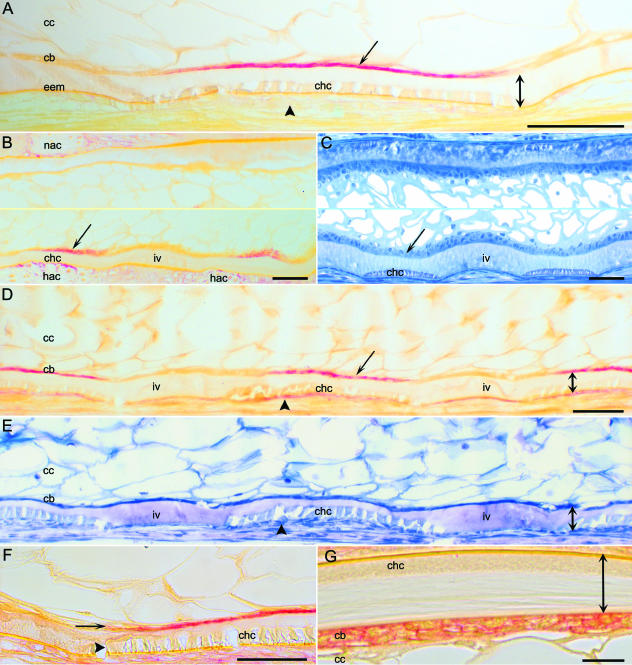Fig. 3.
Segmental alkaline phosphatase (ALP) activity in the chordoblast layer of the notochord. Cranial to the left, and dorsal side up. (A,B,D,F,G) ALP histochemistry. (A) Developmental stage: 680 day°. The ventral part of the notochord from a longitudinal section. During initial chordacentrum (chc) mineralization along the ventral midline of the notochord, ALP activity (arrow) only occurs within the chordoblast layer (cb). There is no ALP activity in mesenchymal cells (arrowhead) external to the external elastic membrane (eem) of the notochord. The full thickness of the notochordal sheath (double arrow) and chordocytes (cc) are indicated. (B,C) Developmental stage: 680 day°. The notochord from longitudinal sections. The middle parts of the images have been omitted. (B) Sagittal section through the notochord and the neural (nac) and haemal arch cartilages (hac). At the onset of chordacentrum mineralization, which starts at the ventral midline, ALP activity (arrow) is present segmentally in the ventral portion of the chordoblast layer. Note that osteoblasts, which form the periochondral bone on the neural and haemal arch cartilages, express ALP activity. The location of the chordacentrum (chc) and the intervertebral region (iv) is indicated. (C) Section similar to B, stained with toluidine blue (figure from Grotmol et al. 2003). The chordacentra (chc) first appear at the ventral midline, in the outer part of the notochordal sheath. The location of a chordoblast subpopulation (arrow), equivalent to the subpopulation that expresses ALP activity, and an intervertebral region (iv) is indicated. (D,E) Developmental stage: 720 day°. The ventral half of the notochord from a longitudinal section. At this stage of development the chordacentra (chc) are complete, and they form full rings (not shown). (D) The ALP activity (arrow) shows a segmental pattern within the chordoblast layer (cb), and, in addition, mesenchymeal cells (preosteoblasts/osteoblasts) that express ALP activity (arrowhead) are present on the external surface of the notochord∖chordacentra (chc). The full thickness of the notochordal sheath (double arrow), the intervertebral regions (iv) and chordocytes (cc) are indicated. (E) Neighbouring section to D, stained with toluidine blue. The chordacentra (chc) appear as mineralized structures within the sheath (double arrow) with mesenchymal cells (preosteoblasts/osteoblasts) on the outer surface (arrowhead). Chordoblasts (cb), chordocytes (cc) and intervertebral region (iv) are indicated. (F) Developmental stage: 790 day°. Sagittal section of the ventral region of the notochord. The distribution of ALP staining (arrow) within the chordoblast layer coincides with the mineralization of the chordacentrum (chc) within the sheath. The arrowhead indicates the rim of the chordacentrum. (G) Developmental stage: 705 day°. Transverse section from the dorsal part of the notochord showing the notochordal sheath (double arrow) with a chordacentrum (chc), the chordoblast layer (cb) and chordocytes (cc). The ALP stain is localized in the area of the plasma membrane of the chordoblasts. Scale bars: (A–F) 50 µm; (G) 10 µm.

